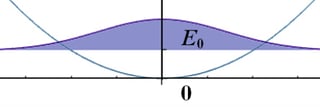Let me start by saying that this is a very difficult question to answer because it's not very hard to come up with pathological cases which I will address at the end. Also, as you point out, it is somewhat non-trivial to calculate $r_0$ from theory and also somewhat non-trivial to determine $r_e$ from experiment. That being said, I think I have a good first suggestion that I am guessing will be hard to beat. I will just answer with theory because this data is more readily available.
$\ce{F^-(H2O)}$:
As has been pointed out, this question is very closely related to the anharmonicity of the vibration in question. The $\ce{O-H}$ stretch of $\ce{F^-(H2O)}$ is the most anharmonic known vibration for a water molecule. This has an experimentally observed vibrational frequency shift of about $2000~\mathrm{cm^{-1}}$ which I'm almost sure is the largest known vibrational frequency shift in a molecular complex, where the molecule in question doesn't dissociate.
Now, that being said, this will vary based on the method used, but at the MP2/AVTZ level, $r_e=1.0653$ angstroms while $r_0=1.1248$ angstroms resulting in a difference of $0.0595$ angstroms.
This $r_0$ value is calculated from VPT2, which is probably the easiest way to calculate this quantity, but this can fail for certain pathological cases like those I'll discuss below.
$\ce{H5O2^+Ar}$:
Ok, now I know that 0.06 angstroms doesn't seem like that huge of a difference, but generally both of these numbers will increase together, so it's hard for them to be all that different. Now, another way you could consider finding a very large difference would be to look for a double-well system where the zero-point energy of the vibration in question is larger than the barrier height.
Now, the zundel cation is a proton shared symmetrically between two water molecules. This is a single well system, however, so $r_e$ and $r_0$ will be the same and they have a calculated $\ce{O-H}$ distance of $1.202$ angstroms at the CCSD(T)/aug-cc-pVDZ level of theory.
If, however, we disturb this system ever so slightly, we will break the symmetry and might get the desired behavior. This can be done by tagging the complex with a rare gas atom, which is often done in experiments as it reduces the noise in spectra for reasons I won't get into.
$\ce{H5O2^+Ar}$ has a hydronium like complex with an elongated $\ce{O-H}$ bond length of $1.108$ ansgtroms. It is very likely that the barrier to proton transfer in this case is very small because there is no barrier in the absence of an Argon atom. Therefore, it is likely that the proton will be close to symmetric after vibrational averaging, so if it were perfectly symmetric, we would get an $r_0$ of $1.202$ angstroms again. It is likely less than this, but it is possible this would lead to a difference greater than $0.06$ angstroms which we got from $\ce{F^-(H2O)}$.
I should point out that calculating $r_0$ for this system is pretty difficult because using VPT2 will almost certainly give nonsensical answers because the harmonic reference is a terrible one, so the perturbation theory will break down. The best option is probably to do diffusion monte carlo and extract the average from the wavefunction directly. It's possible this has been done, but a cursory search of the literature didn't turn anything up.
Also, the data for the first part comes from the SI of ref.[1] and the data for the second part comes from ref.[2].
References:
[1]: Boyer, M. A., Marsalek, O., Heindel, J. P., Markland, T. E., McCoy, A. B., & Xantheas, S. S. (2019). Beyond Badger’s Rule: The Origins and Generality of the Structure–Spectra Relationship of Aqueous Hydrogen Bonds. The journal of physical chemistry letters, 10(5), 918-924.
[2]: Park, M., Shin, I., Singh, N. J., & Kim, K. S. (2007). Eigen and Zundel forms of small protonated water clusters: structures and infrared spectra. The Journal of Physical Chemistry A, 111(42), 10692-10702.

